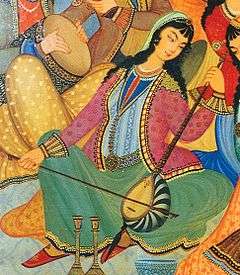Kamancheh
- This article is about the Iranian kamancheh. For the related but different Pontian Greek, Turkish or Azerbaijan instrument see Kemenche.
|
Woman playing the kamancheh in a painting from the Hasht Behesht Palace in Isfahan Persia, 1669. | |
| String instrument | |
|---|---|
| Other names | Kamancha, Kamanche, Kemancheh, Kamanjah, Kabak kemane |
| Classification | Bowed Strings |
| Playing range | |
| g3-e7 | |
| Related instruments | |
| Musicians | |
| Builders | |
| |
The Kamancheh (also kamānche or kamāncha) (Persian: کمانچه, Azerbaijani: kamança), is an Iranian bowed string instrument, used also in Azerbaijani, Turkish, and Kurdish Music and related to the rebab, the historical ancestor of the kamancheh and also to the bowed Byzantine lyra, ancestor of the European violin family.[1] The strings are played with a variable-tension bow: the word "kamancheh" means "little bow" in Persian (kæman, bow, and -cheh, diminutive).[2] It is widely used in the classical music of Iran, Azerbaijan, Uzbekistan, Turkmenistan and Kurdistan Regions with slight variations in the structure of the instrument.[3]
A well known Armenian kamancha player is Sayat-Nova. Other well known players are Ali-Asghar Bahari, Ardeshir Kamkar and Kayhan Kalhor, all from Iran, and the Azeri player, Habil Aliev.
The Turkish kemençe is a bowed string instrument with a very similar or identical name, but it differs significantly in structure and sound from the Persian kamancheh. There is also an instrument called kabak kemane used in Turkish music which is only slightly different from the Persian kamancheh.[4]
History
In the Safavid and Qajar periods, Kamancheh was one of the most important instruments which was used in celebration scenes. Furthermore, it was described in celebration and war scenes paintings, from Mongol and Timurid periods. A wall fresco at Chehel Sotoun Palace in Isfahan shows a Kamancheh player among a group of court musicians at the royal court. A banquet scene of Shah Abbas II was depicted in the wall painting in honor of Nader Mohammad Khan emir of Turkistan in 1646. Additionally, a woman playing the Kamancheh was painted in another wall painting at Hasht Behesh Palace in Isfahan.
Structure
The kamanche has a long neck including fingerboard which kamancheh maker shapes it as a truncated inverse cone for easy bow moving in down section, peg box in both side of which four pegs are placed, and finial[5]Traditionally kamanchehs had three silk strings, but modern instruments have four metal strings. Kamanchehs may have highly ornate inlays and elaborate carved ivory tuning pegs. The body has a long upper neck and a lower bowl-shaped resonating chamber made from a gourd or wood, usually covered with a membrane made from the skin of a lamb, goat or sometimes a fish, on which the bridge is set. From the bottom protrudes a spike to support the kamancheh while it is being played, hence in English the instrument is sometimes called the spiked fiddle. It is played sitting down held like a cello though it is about the length of a viol. The end-pin can rest on the knee or thigh while the player is seated in a chair.
Kamancheh is usually tuned like ordinary violin (G, D, A, E).
 |
Kamancheh Improvisation Played by Kayhan Kalhor - Silk Road Project
|
| Problems playing this file? See media help. | |
See also
References
- ↑ "Iranian string instrument ‘Kamancheh’ to be inscribed on UNESCO list". 11 April 2015. Retrieved 1 May 2015.
- ↑ loghatnaameh.com. "کمانچه - پارسی ویکی".
- ↑ "Pastimes of Central Asians. Musicians. A Man Practising the Kamancha, a Long-necked Stringed Instrument". World Digital Library. Retrieved 14 May 2014.
- ↑ "Kabak kemane ve Kemancha hakkında rehber".
- ↑ Ch, R. A. M.; 51, Rakausika राम च (2013-03-08). "The Masters of Kamanche". A World,s Heritage Of Native Music. Retrieved 2017-05-16.
External links
![]() Media related to Kamancheh at Wikimedia Commons
Media related to Kamancheh at Wikimedia Commons
- Farabi School
- About Kamanche and Kamanche Players
- Nay-Nava: The Encyclopedia of Persian Music Instruments
- An old video of Ali-Asghar Bahari, playing Kamancheh in Hafezieh, shiraz
- Ardeshir Kamkar and Mathaios Tsahouridis (kurdish/greek)
- kamancheh.com
- The song called "Kamancha" composed by Sayat Nova
Kamanche at The Metropolitan Museum of Art:
- Kamanche, Iran, ca. 1880
- Kamanche, Iran, ca. 1869
- Video: Kayhan Kalhor speaking as an ensemble member of Silk Road Ensemble, December 2008: YouTube (13 min).
(Officially released by Silk Road Project – see silkroadproject)




